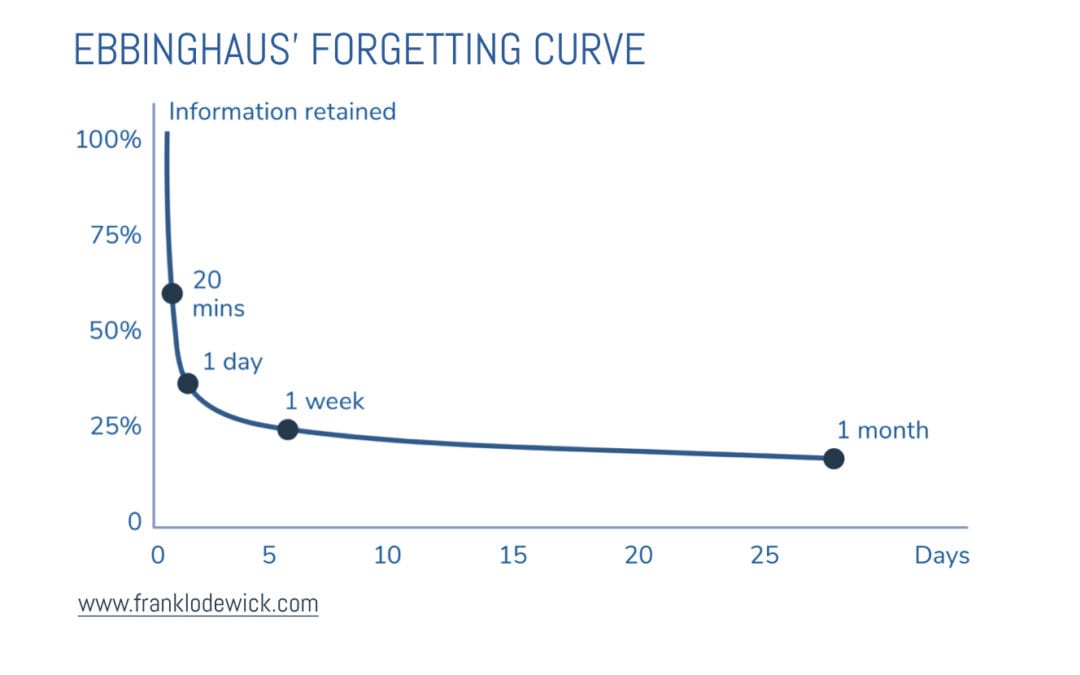Ahh, Q1. The quarter with the most valid excuses and distractions for sales people, including the invigorating Sales Kick Off (SKO). Most of us flew to HQ and were treated to an energetic week packed with reviews of last year, exciting announcements about this year, award ceremonies, and … sales training.
While the excitement of SKO tends to last for a while, the impact of sales training often doesn’t. By the time the hangovers and jet lags have worn off and we get back to work, most of us pick up our old habits like nothing happened. Notwithstanding our great intentions, only a couple nuggets of gold from the multi-day sales training actually end up “sticking”. This is not just an SKO phenomenon; of all the great frameworks, tips and skills that our sales trainings cover, not much ends up properly getting embedded in the field. Why is that? Why is it that so much of this great investment to help increase our win rate, goes to waste?
The answer is nearly 150 years old and was first revealed by Hermann Ebbinghaus who studied the brain’s ability to retain information. Numerous follow-up studies have proven his thesis to still be valid. It’s a pretty simple one. Most of the information that we absorb soon leaves our brain again. Yes, we forget. Quickly. With sobering clarity, Ebbinghaus’ Forgetting Curve illustrates just how quickly. Within one hour, people will have forgotten, on average, 50 percent of the information which they were presented with. Within 24 hours, that memory leak increases to 70 percent. Within a week, people generally have forgotten nearly 80 percent of what was taught. This has nothing to do with intelligence. It’s more of a protection mechanism of the brain. Survival mechanisms have made it selective around spending energy to store information. It’s not the sponge to which we figuratively refer. The brain has built-in protections to cope in overwhelming situations. Like SKO.
e-Learning modules that allow you to process easily digestible snippets of content are only part of the solution. Your brain is still wired to forget most of what it has been presented with.
So what to do?
Focus and repetition is key. As a team, agree on two key elements from the training that you will be holding each other accountable for this quarter. To support the brain in creating the new habits, use templates. For instance, if discovery is your priority this quarter, focus on proper use of the discovery template that (hopefully) came with your training. As a manager (or SC!), if you see poorly filled in templates, go through the discovery questions from the training and coach the rep towards a better completion. If your priority is to elevate the conversation away from features and functions towards business issues, focus on the appropriate template to uncover these. Make a habit of attaching the completed templates to opportunities in your CRM and hold each other accountable. Once you feel comfortable the new habit or skill has properly been embedded (say, 90% of opportunities have a properly completed template), you move on to another set of priorities.
Don’t try to do too much at the same time. If you focus on five priorities, chances are you’ll do a half-assed job on all of them. Just focus on two and do them properly before you move on to the next couple. Oh and just to prove the forgetting curve applies to your brain, too: what % of information has generally been forgotten after 5 minutes?
Like to get more tips on how to get to target with a calm mindset and a smile on your face? In my new book, In the face of challenge: Perseverance in sales, I tell the story of my life-threatening kitesurfing accident that left me in a coma, and explore what my two-year recovery taught me about perseverance. I share over a hundred practical tips for AEs, CSMs, SCs, SDRs and their managers on how to deal with challenges in sales, and how to avoid them in the first place. For more details and a list of retailers who carry the paperback and ebook, see here.

